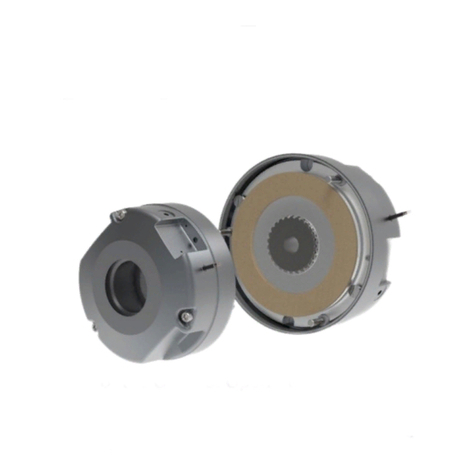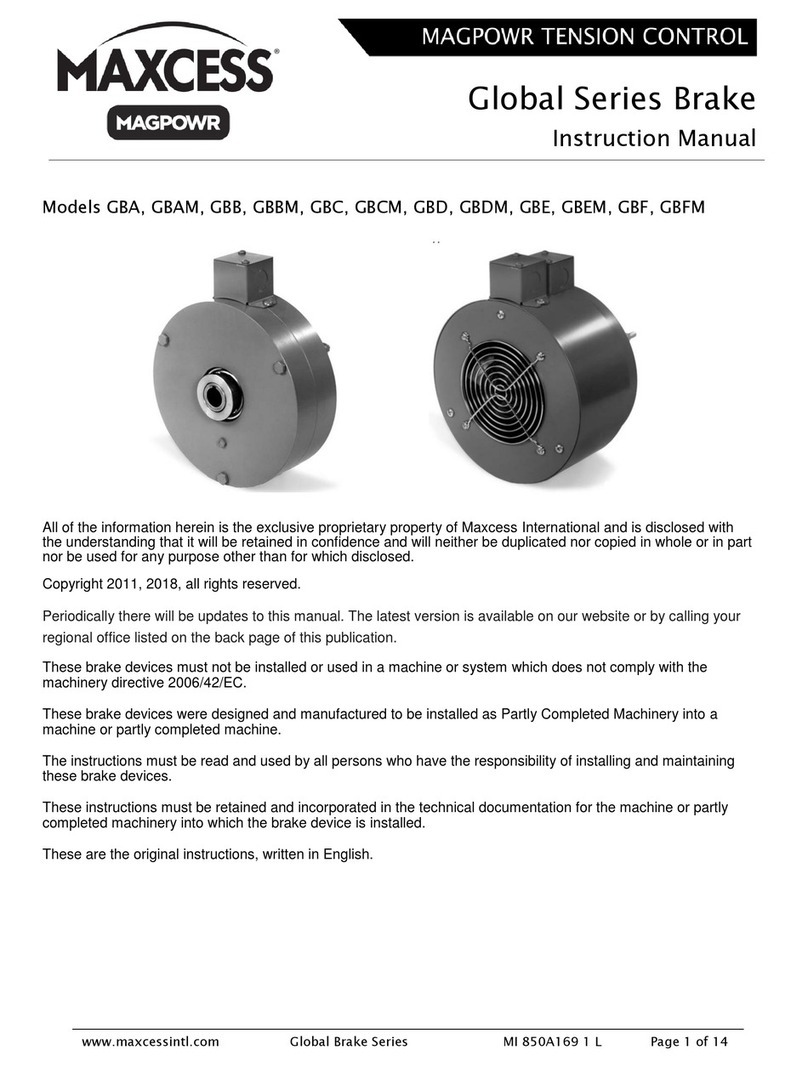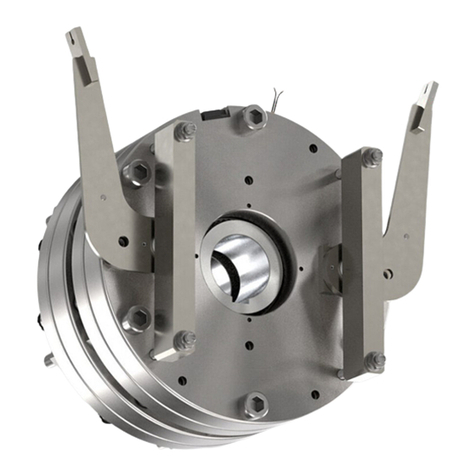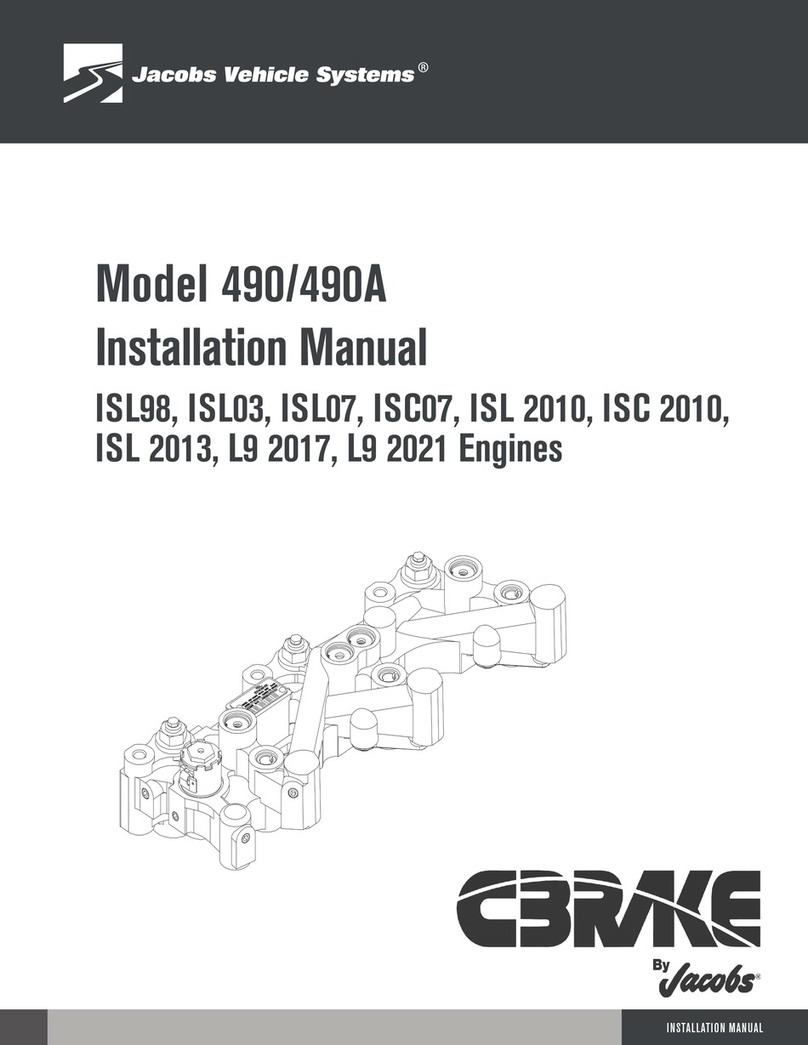Dings 70 Series User manual

70 Series Hazardous
Brake Instructions
DESCRIPTION
The 70 Series Brake is a direct acting, electro magnetically released, spring set unit that utilizes rotating and stationary
disc contact to supply positive braking action with quick release and setting capabilities at all times. Brakes which are
not provided with a floor mounting bracket are intended to be mounted as an integral part of electric motors listed for
corresponding hazardous locations where the acceptability of the combinations has been determined by Underwriter’s
Laboratories, Inc. The explosion-proof assembly is completed by assembly of the brakes to the motors.
READ THIS BULLETIN CAREFULLY BEFORE INSTALLING OR OPERATING THE
70 SERIES BRAKE. FAILURE TO COMPLY WITH THESE INSTRUCTIONS CANCELS
ALL WARRANTIES SINCE THE SAFETY OF THE UNIT MAY BE ENDANGERED BY
IMPROPER INSTALLATION OR OPERATING PROCEDURES.
Bulletin No. BK4606 (8/07)
4740 WEST ELECTRIC AVENUE MILWAUKEE, WI 53219 PHONE 414/672-7830 FAX 414/672-5354 www. dingsco.com
MOTOR MOUNTED* FOOT MOUNTED
MODEL MODEL
NO. Torque NO. Torque
R71010-9 10 lb. ft. FR71010-9 10 lb. ft.
R71015-9 15 lb. ft. FR71015-9 15 lb. ft.
R72025-9 25 lb. ft. FR72025-9 25 lb. ft.
R73035-9 35 lb. ft. FR73035-9 35 lb. ft.
R74050-9 50 lb. ft. FR74050-9 50 lb. ft.
R75075-9 75 lb. ft. FR75075-9 75 lb. ft.
*If a hazardous location brake is purchased by other than an
authorized electric motor manufacturer, a Foot Mounted brake
must be purchased to obtain the UL label.
CAUTION
DO NOT OPERATE MANUAL RELEASE
OR ENERGIZE BRAKE COIL BEFORE
INSTALLATION IN ORDER TO PRESERVE
PRE-ALIGNMENT OF ROTATING DISCS
FOR EASE OF INSTALLATION.
USE ONLY HUB FURNISHED BY DINGS
SPECIFICALLY FOR USE IN HAZARDOUS
LOCATION BRAKES. DO NOT OPERATE
BRAKES IN EXPLOSIVE ATMOSPHERE
WITH COVER OR COVER BOLTS
REMOVED.
MANUAL RELEASE (See Figure 1)
To manually release brake, push in release knob and rotate
counterclockwise until strikes stop-pin. Brake will remain
released until release knob is pushed in and turned clockwise
or until power is restored, automatically resetting the brake.
THERMAL RELEASE
If the brake overheats, the thermal release mechanism will release
spring pressure on the friction discs, releasing brake. To reset ther-
mal release, allow brake to cool, then push in release knob (17)
and rotate clockwise until it strikes the stop-pin. Check brake
operation as overheating may indicate a broken lead wire or
burned out coil.
The thermal release mechanism has been calibrated at the factory
and the setting of the bimetal element and control rod MUST
NOT BE DISTURBED. If the mechanism does not function
properly, the complete pressure plate assembly (9), complete
magnet plate assembly (3), release gears (34) and items 31
through 50 must be returned to the factory for adjustments.
G060629-006
Figure 1.
Table 1. List of Models

WARNINGS
A. Read this bulletin carefully before installing or operating the brakes. Failure to comply
with the installation or operating instructions cancels all warranties and may cause
injury to personnel and damage to property.
B. DESCRIPTION
The 70 Series brake for hazardous location is a direct acting, electromagnetically
released, spring set brake that utilizes rotating and stationary disc contact to supply
positive braking action. Brakes can be mounted independently of any other equipment
by using a U.L. listed foot mounting bracket, or mounted to an electric motor listed for
hazardous locations. The brakes are equipped with a thermal overload mechanism that
prevents the external surfaces of the unit from exceeding the temperature rating for the
brake.
C. OPERATING INFORMATION
When the external surface of the brake approaches its temperature rating, the thermal
overload mechanism will automatically release the brake and hold it in the released
position. This prevents ignition of gases or suspended solis, assuming that brake’s
temperature rating is less than the air ignition temperature. The thermal overload
mechanism prevents the surface temperature of the brake from rising to a level that
could ignite the surrounding gases or dusts by releasing the brake and therefore,
stopping a further increase in temperature. Once the brake has been released by the
thermal overload mechanism, control over the rotation of the motor and the load is lost.
This uncontrolled rotation of the motor and movement of the load could cause injury to
personnel and damage to property.
2

The thermal overload mechanism can be reset manually after a cooling off period. Before
resetting, the root cause for actuating the thermal overload mechanism needs to be determined
and corrected.
To minimize the possibility of overheating the brake to a point where the thermal overload
mechanism will be actuated, the performance of the brake has to be matched to the requirements
of the application.
When selecting the brake model, consideration has to be given to brake torque, thermal
capacity, electrical power supply, housing material and any unusual conditions.
BRAKE TORQUE
As a general rule, brake torque is matched to the full load motor torque (brake and motor shaft
at the same speed). Depending on the type of application, the torque sometimes is increased by
a safety factor of 1.5 to 2. If factors such as stopping time, travel distance during stopping and
others, are important, the exact torque requirement has to be calculated, using the methods
contained in Dings selection guide.
THERMAL CAPACITY
Thermal capacity describes the capacity of the brake to perform the maximum number of
stops without excessive heat buildup that will actuate the thermal overload mechanism or
damage internal brake parts. The maximum number of stops depends on the rating of the brake,
load to be stopped and speed from which stops are made. To calculate the thermal capacity
requirements of the application, use the methods contained in Dings selection guide.
ELECTRICAL POWER SUPPLY
The coil of the electromagnet, which supplies the releasing force under normal operating
conditions, will operate properly with a tolerance of plus or minus 10% of rated voltage. A volt-
age higher than 110% will shorten the life of the coil considerably due to the higher temper-
ature generated inside the coil. A voltage of less than 90% may prevent the armature from mov-
ing towards the magnet frame. If this occurs, the coil will burn out within months.
UNUSUAL CONDITIONS
Please consult Dings Home Office, if ambient temperature is above 40oC (104oF), brake shaft
speed is over 3600 RPM, or any other unusual conditions exist.
3

Item Description Part
No. No.
1 Cover K070091-001
2 Gap Adjusting Nut W003001-022
3 Magnet & Coil Assembly, 3 Phase K070283-***
3 Magnet & Coil Assembly, 1 Phase K070282-***
4 Gap Adjusting Nut W003008-022
5 Torque Adjusting Nut W003001-023
6 Adjusting Nut Washer W004004-014
7 Torque Spring, 10 & 35 lb. ft. G070011-001
7 Torque Spring, 15 & 75 lb. ft. G070012-001
7 Torque Spring, 25 & 50 lb. ft. G070019-001
8 Stud G070175-***
9 Pressure Plate K070048-002
10 Rotating Friction Disc 10 - 50 lb. ft. H070103-005
10 Rotating Friction Disc 75 lb. ft. H020009-002
11 Stationary Disc 25 - 75 lb. ft. only K070485-001
12 Stud Lock Pin W005005-001
13 Brake Bracket L070066-***
14 Hub Assembly H070044-***
15 Mounting Bolt (not shown) W001013-132
16 Locking Screw W002002-001
17 Manual Release & Reset Knob G070141-003
18 Knob Release Spring G070202-001
19 Knob Roll Pin W005003-044
20 Reset Arm G070156-001
21 Cover Bolts W001013-108
22 Lock Washer W004006-008
23 Wiring Harness Guide G070218-001
24 Wiring Harness Clamp W021001-001
Item Description Part
No. No.
25 Clamp Screw W001002-051
26 Coil, 3 Phase (included in item 3) H070033-***
26 Coil, 1 Phase (included in item 3) H070035-***
27 Insulating Washer, 3 Phase G070037-001
27 Insulating Washer, 1 Phase G070029-001
28 Condulet Assembly G070148-001
29 Nameplate H050020-001
30 Press Nut W003012-024
31 Drive Gear G070167-001
32 Pivot Stud G070153-001
33 Release Rod w/ Snap Ring G070134-002
34 Release Gear G070140-001
35 Release Bearing W009002-001
36 Release Rod Spring G060010-001
37 Release Reset Spring G070159-001
38 Release Stop Stud G070144-001
39 Driver G070152-001
40 Lock Bushing G070119-001
41 Lock Pin G070157-001
42 Lock Spring G070158-001
43 Felt Washer G070162-001
44 Washer W004001-003
45 Control Rod Wiper Assembly*
46 Control Rod Assembly*
47 Thermal Release Bracket Assembly*
49 Driver Spring Stud G070143-001
50 Drive Spring (1, 2, & 3 Disc) G070160-001
50 Drive Spring (4 & 5 Disc) G070160-002
4
*Install only at factory.
***Varies by brake model–provide model and serial number.

INSTALLATION OF BRAKE ON MOTOR
ENDSHIELD (See Figures 2, 3 and Table 4)
Do not operate manual release or energize brake coil before
installation in order to preserve pre-alignment of rotating disc
for easy installation of brake to motor.
Because of the close fit on all joints (bracket, cover, hub), care
should be taken to prevent damage to all machined surfaces.
Do not operate brake in hazardous location with cover removed.
All testing must be done in a non-explosive atmosphere.
1. Remove hub (14) from brake and mount hub with key (not
supplied by Dings) on motor shaft per dimension “BC” shown
in Figure 2. Be sure that hub used is item supplied by Dings
for hazardous location applications. Tighten both set screws to
8-10 lb. ft. torque.
2. Remove four cover bolts (21) and tap cover with soft mallet.
Remove cover (1). Do not operate the manual release (17)
until brake is installed.
3. Inspect motor “C” flange and remove any nicks or burrs. This
will assure a precision fit of brake to motor flange. Slide
brake over hub (14), engaging teeth of rotating disc (10) and
hub.
4. Install four mounting bolts (15) and tighten. Install four
locking set screws (16) and tighten to 40 lb. ft. torque. This
seals flame path around mounting bolts. Check rotation of hub
to make certain it does not rub in bracket (13). Diametrical
clearance or hub outside diameter to bracket bore shall not
exceed .024”.
5. Connect brake leads to power as shown in Figure 3. All
wiring should be positioned to prevent pinching or chafing
and all connections well taped to prevent grounding.
6. Replace cover (1). This may be done more easily by threading
a 3/8” dia. by 5” long stud (threaded one end 3/8-16NC) into
one cover bolt hole in magnet plate assembly (3) as guide.
Slide cover into position using stud as a guide and tap with
soft mallet until cover seats. Use care in assembly. Insert 3
cover bolts (21) and finger tighten. Remove guide stud and
insert fourth cover bolt. Draw up all bolts evenly and tighten
until spring washer (22) is fully compressed. A loose or
missing bolt will render the brake unsafe for operation in
hazardous locations.
INSTALLATION OF BRAKE WITH ADAPTER
ON MOTOR ENDSHIELD (See Figure 4)
7. Inspect motor “C” flange and remove any nicks or burrs. This
will insure a precision fit of adapter to the motor flange.
Mount adapter to motor flange using the four bolts and lock
washers supplied. A soft mallet may be used to tap adapter
into place. All bolts should be drawn up evenly and tight.
8. Check alignment or adapter. Clamp dial indicator to brake
hub (position A) and measure pilot eccentricity. This must
not exceed .006” total indicator reading for a full revolution
of hub. Reposition dial indicator (position B) and check
adapter face runout which must not exceed .006” total
indicator reading a full revolution of the shaft. Remove hub
(14) from brake and mount hub with key (not supplied by
Dings) on motor shaft per dimension shown in Figure 2.
Tighten both setscrews to 8-10 lb. ft. torque. Complete
mounting of brake per paragraphs 2 through 6.
Figure 2. Wiring Connections
Figure 3. Adapter Installation
ITEM PART NO.
NO. DESCRIPTION NO. REQ.
3 Magnet assembly with coils -- 1
26 Magnet coil (3 phase) H070033 6
26A “ “ (1 phase) H070035 2
27 Insulating washer (3 phase) G070037 4
27A “ “ (1 phase) G070029 4
51 Shading coil (1 phase only) G070032 2
Table 2. Electrical Parts List
5

Torque “BC” Spring Shaft Length Magnet Gap “A”
Model Number Lb. Ft. +1/32 -.000 Length “D” “AH” Max. A-Min. A-Max.
R71010-9 10 5/8 1-5/16 3-7/16 .030 .062
R71015-9 15 5/8 1-5/16 3-7/16 .030 .062
R72025-9 25 5/8 1-5/16 3-3/4 .030 .062
R73035-9 35 5/8 1-5/16 4-3/8 .035 .062
R74050-9 50 5/8 1-5/16 5-1/8 .035 .062
R75075-9 75 5/8 1-5/16 5-1/8 .045 .062
INSTALLATION OF FOOT MOUNTING
BRAKE (See Tables 4, 5 & Figure 5)
9. Install bracket (F1) over motor shaft extension and half-
tighten capscrews (F8). The distance from the mounting face
of the bracket (F1) to end of motor shaft must not exceed
dimension “AH” max. (Table 5).
10. Clamp dial indicator “A” to motor shaft and position bracket
(F1) with shims as necessary, by tapping with a soft mallet
until dial indicator does not read over .002” total change in
one full revolution of the shaft. Move dial indicator to “B”
and position bracket until dial indicator does not read over
.004” total change in one full revolution of shaft.
11. Draw all bolts up tight. Recheck alignment with dial indicator.
Readjust if necessary until tolerances are within limits with all
bolts tight. Drill eight 1/4” dia. holes into mating parts and
drive dowel pins (F7) into place.
12. Mount stop bushing (F3) on shaft with clearance of .005” to
.015” between bushing and bracket (F1). Mount hub (14) on
shaft butting firmly against stop bushing. Complete mounting
of brake per paragraphs 2 through 6.
WEAR ADJUSTMENT (See Figure 2 & Table 4)
13. The magnet gap “A” increases as the friction discs wear.
When magnet gap measures “A-Max,” adjust to “A-Min”
using gap adjusting nuts (2) and (4). Magnet gap must never
exceed “A-Max” and must be adjusted periodically.
ITEM DESCRIPTION QTY PART NUMBER
F1 Foot Mtg. Bracket 1 K070066-001
F2 Foot Pad 2 G070180-001
F3 Stop Bushing 1 G070181-*
F4 Set Screw 2 W002001-013
F5 Hx. Hd. Cap Screw 4 W001007-055
F6 Split Lockwasher 8 W004006-008
F7 Roll Pin 8 W005003-170
F8 Hx. Hd. Cap Screw 4 W001007-058
14 Hub 1 H070044-*
15 Mounting Bolt 4 W001013-132
16 Locking Screw 4 W002002-001
*Specify bore
MODEL 71010 71015 72025 73035 74050 75075
“AH” 4-3/4 4-3/4 5-1/16 5-11/16 6-7/16 6-7/16
Table 4. Adjustments
Table 5. Foot Mounting Parts
Figure 5.
6

TORQUE ADJUSTMENT
(See Figure 2 & Table 4)
14. Adjust length of torque springs (7) to dimension “D” for
rated torque. To decrease torque, increase spring length
(“D” max =1-1/2”). Both torque springs must be adjusted
to the same length.
FRICTION DISC REPLACEMENT
(See Figure 2)
15. Remove cover screws (21) and cover (1).
16. Remove pivot stud (32), reset spring (37), drive gear (31),
drive spring (50), and driver (39). Unscrew release gear (34)
and remove release bearing (35). Remove gap adjusting nut
(2), reset spring (37) and drive spring (50).
17. Remove magnet plate (3). Take care not to bend control rod
assembly (45).
18. Remove gap adjusting nut (4), torque nut (5), washer (6) and
torque spring (7). Remove pressure plate (9). The friction
discs (10) may now be replaced.
19. Reassemble brake. Replace pressure plate (9), torque spring
(7), washer (6) and torque nut (5). Set spring length to
dimension “D” (Fig. 2). Assembly gap adjusting nut (4) and
magnet plate (3) taking care not to bend control rod assembly
(46). Set magnet gap to dimension “A” (Fig. 2 and Table 4).
20. Install two release bearings (35) into recesses of magnet
plate (3). Thread two release gears (34) onto release rods (33).
Turn release gears (34) clockwise until snug but do not raise
pressure plate (9). Make certain that release rods (33) are
seated in the pressure plate recesses.
21. Insert lock spring (42) and lock pin (41) in the underside of
the driver (39) and center the driver (39) on magnet plate (3)
at same time engaging lock pin (41) in lock bushing (40).
22. Insert pivot stud (32) into drive gear (31) and driver (39).
Line up marked teeth of release gears (34) and drive gear (31)
and tighten pivot stud into magnet plate (3). Install drive
spring (50) and reset spring (37). Check operation of manual
release mechanism. Mount brake cover (See Paragraphs 2 to
6).
23. Alternate method of lining up release mechanism if markings
not visible: Turn release gears (34) clockwise until both are
tight and magnet gap is fully closed. Rotate release gears (34)
counterclockwise from vertical centerline and center of brake
10 roots (valleys) of teeth. Drive gear (31) is to engage this
tenth root the following number of teeth from top right and
lower left edge of drive gear (31): 1 disc = 5, 2 disc = 6,
3 disc = 7, 4 disc = 8, and 5 disc = 9. Then continue per
paragraph 23. Do not tamper with thermal release mechanism
or control rod setting.
MAGNET COIL REPLACEMENT
(See Figures 2, 3 & 6 and Table 3)
24. Remove magnet assembly (3) (See Paragraphs 15 to 16).
25. Remove shading coils (51) (Single phase brakes only).
26. Coils (26) are held in place by epoxy cement or by bent over
end laminations. Force coil off magnet if held by epoxy. Remove
excess epoxy from magnet surfaces or bend up laminations and
remove coils.
27. Replacement coils are held in place by bending of end lami-
nations (See Figure 6). Insulating washers (27) are used above and
below on replacements. Remember this when ordering replacement
coils.
28. Replace coils. Sequence of black and yellow leads must be
maintained (See Figure 3). Important: Shading coils must be
replaced and held securely by staking in center of shading coil slot
or by cementing with epoxy. Bend down end laminations to
securely hold coils.
29. Reassemble brake (See Paragraphs 19 to 22).
Figure 6. Fastening of Replacement Magnet Coils
7

TROUBLESHOOTING
BRAKE DOES NOT RELEASE
Check for failure of power supply to brake.
Check brake visually for broken or damaged parts.
Check for broken leadwire or bad electrical connection.
Check for correct voltage. Voltage must correspond to that listed
on brake nameplate. If voltage is more than 10% below figure
stamped on nameplate, magnet will not pull in, causing coil to
burn out within minutes. If voltage is more than 10% above,
coil will overheat and burn out.
Check for burned out coils (coils may be charred or burned).
Check for excessive magnet gap (See WEAR ADJUSTMENT).
BRAKE DOES NOT STOP
Check manual release. Drive gear must be turned completely
clockwise.
Check thermal release. Release may have tripped.
Check brake visually for broken or damaged parts.
Check disc wear (See WEAR ADJUSTMENT).
Check for broken friction disc.
Make certain hub has not shifted position on shaft and that all
rotating discs are fully engaged on hub.
BRAKE CHATTERS OR HUMS
Clean magnet faces if dirty. Insert a clean sheet of paper between
magnet faces and energize brake. Move paper around between
faces to dislodge dirt. Finally, remove paper.
Check that magnet faces are parallel in closed position. If not
parallel along length of magnet, adjust (See WEAR
ADJUSTMENT).
Check if shading coil is cracked, broken or out of position.
Check for low voltage. Magnet will not pull in and coil will burn
out if voltage is more than 10% below figure stamped on
nameplate.
SPECIFICATIONS
For NEMA Frames 213TC, 215TC, 254TC, and 256TC.
Adapters available for many other frames.
HEATERS: UL listed heaters available.
VOLTAGES: All standard NEMA 3 phase and single phase
voltages and frequencies available. Other voltages and
frequencies optional. Add suffix “S” to model number to
denote single phase.
TORQUE: 10, 15, 25, 35, 50 and 75 lb. ft. available.
ORDERING INFORMATION
The following information should be furnished with your order for:
REPLACEMENT PARTS
Brake Model Number
Part Number from Pages 2, 3, or 4.
Part Description from Pages 2, 3, or 4. (On hub order, bore
diameter & keyway dimensions. On electrical parts, specify
voltage, phase & frequency.)
REPLACEMENT BRAKE
Model Number
Voltage, Phase & Frequency
Hub Bore & Keyway Dimensions
Mounting - Horizontal or Vertical (If vertical, specify
whether above or below motor. If brake includes foot
mounting bracket or adapter, specify.)
4740 WEST ELECTRIC AVENUE MILWAUKEE, WI 53219 PHONE 414/672-7830 FAX 414/672-5354 www. dingsco.com
WARRANTY
Seller warrants products manufactured by it and supplied
hereunder to be free from defects in materials and work-
manship under normal use and proper maintenance for a
period of twelve months from date of shipment. If within
such period any such products shall be proved to Seller’s
reasonable satisfaction to be defective, such products shall
be repaired or replaced at Seller’s option Seller’s obligation
and Buyer’s exclusive remedy hereunder shall be limited to
such repair and replacement and shall be conditioned upon
Seller’s receiving written notice of any alleged defect no
later than 10 days after its discovery within the warranty
period and, at Seller’s option, the return of such products to
Seller, f.o.b. its factory, when such return is feasible. Seller
reserves the right to satisfy its warranty obligation in full by
reimbursing Buyer for all payments it makes hereunder, and
Buyer shall thereupon return the products to Seller. Seller
shall have the right to remedy such defects. Seller makes
no warranty with respect to wear or use items, such as belts,
chains, sprockets, discs and coils, all which are sold strictly
AS IS.
The foregoing warranties are exclusive and in lieu
of all other express and implied warranties (except of
title) including but not limited to implied warranties
of merchantability, fitness for a particular purpose,
performance, or otherwise, and in no event shall the
Seller be liable for claims (based upon breach of express
or implied warranty, negligence, product liability, or
otherwise) for any other damages, whether direct, immediate,
incidental, foreseeable, consequential, or special.
This manual suits for next models
12
Table of contents



